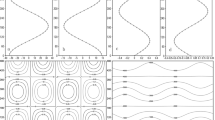Abstract
A two-layer model includes three parameters: interface depth h 1, upper layer density \(\rho_{1}\), and lower layer density \(\rho_{2}\). Many theoretical and laboratorial studies of internal waves, as well as most numerical models, are based on the two-layer assumption. However, these three parameters cannot be directly measured because a pycnocline in the real ocean has finite thickness, and the densities in both the mixed layer and the deep ocean are not constant. In the present study, seven different methods are used to determine the interface depth of the two-layer model and compared with the depth of maximum vertical displacement: the depth of maximum buoyancy frequency (Ν max), the depth where the first mode eigenfunction has its maximum (Φmax), the depth where the lowest mode temperature empirical orthogonal function has its maximum, the depth where either the two-layer Korteweg–de Vries (KdV) or Benjamin–Ono equation has closest coefficients with their continuously stratified counterparts, and the same KdV approach with stratification replaced by two idealized distributions. The multi-ship measurement conducted near the Luzon Strait is used for deep ocean comparison, and two measurements conducted in the east of Dongsha Atoll are used for shallow water comparison. The results show that in the deep ocean, the KdV approach with idealized type I stratification gives the interface closest to the depth of maximum vertical displacement. In shallow waters, the KdV approach agrees with the measurement best.










Similar content being viewed by others
References
Benjamin TB (1966) Internal waves of finite amplitude and permanent form. J Fluid Mech 25:241–270
Camassa R, Tiron R (2011) Optimal two-layer approximation for continuous density stratification. J Fluid Mech 669:32–54
Chen G-Y, Wu R-J, Wang Y-H (2010) Interaction between internal solitary waves and an isolated Atoll in the Northern South China Sea. Ocean Dyn 60:1285–1292. doi:10.1007/s10236-010-0323-1
Chen G-Y, Liu C-T, Wang Y-H, Hsu M-K (2011a) Interaction and generation of ultra-large long-crested internal solitary waves in the South China Sea. J Geophys Research Oceans 116:C06013. doi:10.1029/2010JC006392
Chen G-Y, Su F-C, Wang C-M, Liu C-T, Tseng R-S (2011b) Deriving amplitude of internal solitary waves in deep South China Sea from satellite images. J Oceanogr 67. doi:10.1007/s10872-011-0073-9
Choi W, Camassa R (1999) Fully nonlinear internal waves in a two-fluid system. J Fluid Mech 396:1–36
Fu K-H, Wang Y-H, St L, Laurent H, Wang Simmons D-P (2012) Shoaling of large-amplitude nonlinear internal waves at Dongsha Atoll in the northern South China Sea. Cont Shelf Res. doi:10.1016/j.csr.2012.01.010
Gill AE (1982) Atmosphere-ocean dynamics. Academic Press, New York
Groen P (1948) Contribution to the theory of internal waves. Koninklijk Nederlands Meteorologisch Instituut Mededelingen en Verhandelingen B11:1–23
Halldor B, Venegas SA (1997) A manual for EOF and SVD analyses of climate data. McGill University. CCGCR Report No. 97-1, Montreal, Quebec
Helfrich KR, Grimshaw RHJ (2008) Nonlinear disintegration of the internal tide. J Phys Oceanogr 38:686–701
Joseph RI (1977) Solitary waves in a finite depth fluid. J Phys A Math Gen 10(12):L225–L227. doi:10.1088/0305-4470/10/12/002
Klymak JM, Pinkel R, Liu CT, Liu AK, David L (2006) Prototypical solitons in the South China Sea. Geophys Res Lett 33:L11607. doi:10.1029/2006GL025932
Lee C-Y, Beardsley RC (1974) The generation of long nonlinear internal waves in a weakly stratified shear flow. J Geophys Res 79(3):453–462. doi:10.1029/JC079i003p00453
Liu AK (1988) Analysis of nonlinear internal waves in New York Bight. J Geophys Research 93:12317–12329
Liu C-T, Pinkel R, Hsu M-K, Klymak JM, Chen H-W, Villanoy C (2006) Nonlinear internal waves from the Luzon Strait. Eos Trans Am Geophys Union 87(42):449–451
Ono H (1975) Algebraic solitary waves in stratified fluids. J Phys Soc Japan 39:1082–1091
Ostrovsky LA, Stepanyants YA (2005) Internal solitons in laboratory experiments: comparison with theoretical models. Chaos 15(3):037111. doi:10.1063/1.2107087
Simmons H, Chang M-H, Chang Y-T, Chao S-Y, Fringer O, Jackson CR, Ko D-S (2011) Modeling and prediction of internal waves in the South China Sea. Oceanography 24(4):88–99
Vlasenko V, Stashchuk N, Hutter K (2005) Baroclinic tides: theoretical modeling and observational evidence. Cambridge University Press, New York
Xie J, Cai S, He Y (2010) A continuously stratified nonlinear model for internal solitary waves in the northern South China Sea. Chin J Oceanol Limnol 28(5):1040–1048
Yang YJ, Tang TY, Chang MH, Liu AK, Hsu MK, Ramp SR (2004) Solitons Northeast of Tung-Sha Island during the ASIAEX Pilot Studies. IEEE J Ocean Eng 29:1182–1199
Acknowledgments
This research was completed with grants from Aim for the Top University Plan from the Ministry of Education and National Science Council of Taiwan, Republic of China (NSC101-2611-M-110-005-). Comments and suggestions from two anonymous reviewers are appreciated. We are also grateful to Prof. C.-T. Liu and Prof. R.-S. Tseng for providing the measurements at FB1, FB2 and RV/OR3.
Author information
Authors and Affiliations
Corresponding author
Rights and permissions
About this article
Cite this article
Chen, GY., Wu, CL. & Wang, YH. Interface depth used in a two-layer model of nonlinear internal waves. J Oceanogr 70, 329–342 (2014). https://doi.org/10.1007/s10872-014-0233-9
Received:
Revised:
Accepted:
Published:
Issue Date:
DOI: https://doi.org/10.1007/s10872-014-0233-9




